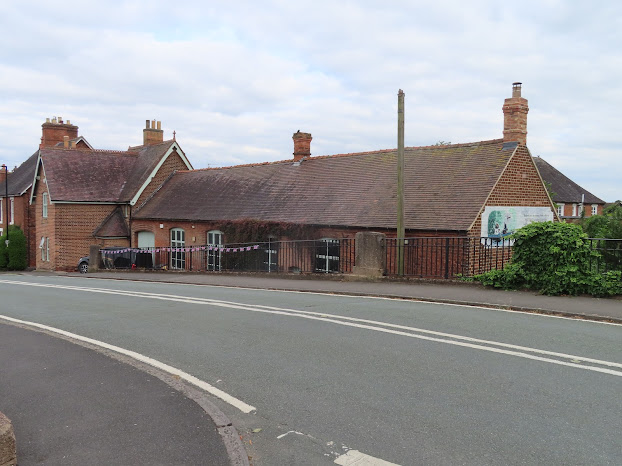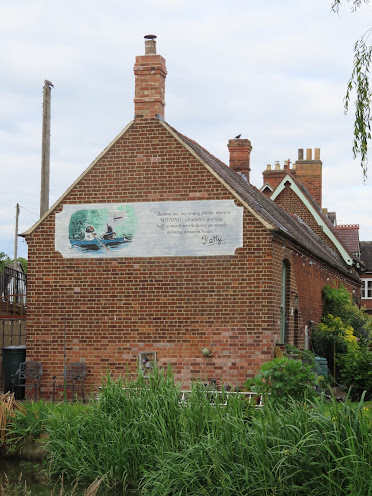We have stayed put today as we have a date tomorrow so there were a few odd jobs, a bit of shopping and a walk around the village.
All Saints Church has an extensive church yard by the canal. There has been a church on this site since 822. Some say it was founded by St. Chad himself. I would love to have a look a round the church at some time.
The lych gate dates from 1891. I suppose it dates back to the Victoria ideas of a formal death when the coffin would rest here before the Vicar arrived to conduct the service. It has already been restored twice and does look splendid.
Mill End Lane is the oldest part of the village and there are some lovely buildings in the area. As there is no through road it is a nice and quiet spot too.
At Church Road Bridge is Wharfingers Cottage and this was one of several coal wharves in the village. On the chimney breast is a coat of arms. It may represent the Stafford family or the Lane family of King's Bromley. The building may also have been used as a chapel for the boat families.
William Dumolo was born in Alrewas in 1845 and was a butcher. He had the house and shop built in 1892 and it was/is called Victoria House. The butchers were taken over by three generations of Coates family. There is a black and white building in the back that was their abattoir but is now their office. There must be a modern abattoir as they still do the whole process on site. The shop is well know to boaters, and we couldn't resist a pork pie, and several other bits and pieces.
I noticed this little building down Main Street. I wonder if it housed a generator at some stage.
Down Post Office Road we spotted this car that seems to be waiting for full restoration, or maybe just a polish!
By the Main Street canal bridge is the old canal horse stables. There was a full blacksmiths there as well so the full service could be offered. In 2005 it was bought in a dilapidated state for £340,000 for a to bedroom place. It is now worth about £550,000
It is the old stables that has the mural and quote from Wind in the Willows by Kenneth Grahame.
I'm sure that I have been close to the mill in Alrewas previously, maybe on a walk through the fields behind it, but you can't now approach it at the front due to a gated housing estate on the land. There has been a mill on this site since before 1660 and the present one was built 1784 and was a cotton mill and was built by Thomas Dicken. It was 1800 that the first consignment of cotton was brought via the canal from Liverpool rather than up the Trent Navigation.It spun cotton and worsted. It its peak in the late 1790's about 300 were employed. Children and women were employed in numbers. There was also a corn mill on the other side of the mill stream. Dicken went bankrupt and the cotton mill was up for sale for a knock down price of £4,000. It had cost £20,000 to build! A year later it had a 45HP steam engine and boiler added. It had its own gas works to light the buildings. There was an Apprentices house, maybe for children to be housed and a row of workers cottages with a managers house.
In 1808 the front and roof were badly damaged by fire. It seems that at the time it was owned by Sir Robert Peel. In 1811 William Farrington, 22, confessed to the fire, and after trial was condemned to death. However the judges met again as the man was considered an 'idiot' and the sentence was commuted. After the fire it was going to be demolished but in the end was rebuilt. the cotton and wool mill declined and by 1861 the cotton mill was closed. The Earl of Lichfield then acquired all the site. The corn mill had been going strong all this time and driven by a water wheel. The site was leased by M and W Bond tape manufacturers and William Shaw miller in 1844. The Bond family were involved in the tape mill until 1908 when they moved to Mayfield and confusingly called their mill there Alrewas Mill. The corn mill was run by the Alrewas Flour Mill Co. owned by the Earl of Lichfield and run by Joseph Cartwright.
To cut a long story short in 1972 Alrewas Flour Mill was amalgamated with several other mills under Rank Hovis McDougal and became DALCO Agriculture making animal feed. It was sold to Midland Pig Producers. In 1989 the first application to change use to residential was submitted with the mill becoming apartments and 90 homes in the grounds. Eventually this was passed in 1994 with only 20 homes and in October that year manufacture ceased.
The 5 storey mill
Alrewas Mill in 1990.













No comments:
Post a Comment